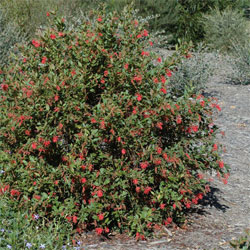Grevillea rhyolitica
 |
 |
Sometimes sold with the cultivar-like name: Grevillea 'Deua Flame'
Deua Flame
Grevillea rhyolitica, commonly known as the Deua Flame, is one of over 350 Grevilleas belonging to the family Proteaceae. It has been classified as a Rare or Threatened Australian Plant (ROTAP) due to its restricted range. It occurs naturally in the sub coastal montane areas of the NSW south coast, from NW to SW of Moruya in the Dampier State Forest and Deua National Park.
 The
subspecies rhyolitica is a spreading shrub, growing up to 2m in height.
This form has the wider range, occurring naturally in moist gullies and steep
ridges, from open forests and shrublands, to riparian forests. It occurs on
skeletal soils on rhyolite rocks.
The
subspecies rhyolitica is a spreading shrub, growing up to 2m in height.
This form has the wider range, occurring naturally in moist gullies and steep
ridges, from open forests and shrublands, to riparian forests. It occurs on
skeletal soils on rhyolite rocks.
The subspecies semivestita is a dense, rounded shrub approximately 1x1m in size. It occurs in coastal mountain ranges, in skeletal soils on steep upper slopes, below rock outcrops of rhyolite.
The subspecies semivestita is more desirable horticulturaly due to its dense, compact size, and almost continuous flowering period. It’s brilliant red flower heads produce abundant nectar so will attract a variety of nectar-eating birds to the garden. This form prefers a relatively sunny aspect, however, will tolerate shade. It is also frost and coast tolerant, making it suitable for a range of garden conditions throughout the country.
Maintenance in the form of fertilising is unnecessary as it is adapted to low levels of soil nutrients. Regular pruning is required as this will encourage dense growth and increase flowering.
The preferred method of propagation for G. rhyolitica is by cuttings. This is standard for most grevilleas as seed is rarely available and often poses difficulties in germination. Cuttings have a high strike rate and begin flowering earlier than plants grown from seed.
In order to maintain a healthy garden plant, the conditions must be suitable for propagation. G. rhyolitica requires a well-drained garden bed, with coarse, slightly acidic soil. Borers and scale insects are common pests to grevilleas and can cause considerable damage, leading to death if left unchecked. A minor effect of scale infestation is the growth of black sooty mould. This looks unsightly but is relatively harmless. In some regions of Australia Phytopthera and other diseases threaten both wild and cultivated populations. Most pests can be treated with commercial pesticides.
Grevillea rhyolitica has been available for cultivation since the early 1990’s. It has high potential for hybridization with other grevillea species.
Text by Kate Alexander (Botanical Intern 2003)
Derivation of scientific name: Grevillea rhyoliticaGrevillea- after C.F. Greville (1749-1809), a patron of botany and president of the Royal Society of London. rhyolitica- refers to the occurrence of this species on outcrops of rhyolite rock. |
References
Harden.G.J, Hardin.D.W, Godden.D.C. (ed) 2000. Proteaceae of New South Wales. UNSW Press, Sydney, NSW.
Olde.P. & Marriot.N. 1994. The Grevillea book. Kangaro Press, NSW.
Makinson. R.O. New segregate species and subspecies of Grevillea victoriae. Telopea 7 (2): 1997.
Grevillea rhyolitica
http://home.bluepin.net.au/yallaroo/Grevillea_rhyolitica.htm
[accessed 17/02/03]Garden Web Australia
http://www.au.gardenweb.com
[accessed 17/02/03]The Genus Grevillea- part 2
http://www.trump.net.au
[accessed 17/02/03]
![An Australian Government Initiative [logo]](/images/austgovt_brown_90px.gif)

